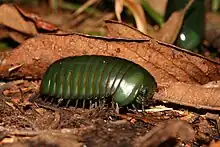| Zoosphaerium neptunus | |
|---|---|
 | |
| Scientific classification | |
| Domain: | Eukaryota |
| Kingdom: | Animalia |
| Phylum: | Arthropoda |
| Subphylum: | Myriapoda |
| Class: | Diplopoda |
| Order: | Sphaerotheriida |
| Family: | Arthrosphaeridae |
| Genus: | Zoosphaerium |
| Species: | Z. neptunus |
| Binomial name | |
| Zoosphaerium neptunus (Butler 1872) | |
 | |
| Distribution of Zoosphaerium neptunus | |
| Synonyms | |
| |
Zoosphaerium neptunus, also known as the giant emerald pill millipede, is a species of millipede within the family Arthrosphaeridae.[1] Its size is an example of island gigantism,[2] it being the largest known pill-millipede in the world, with some individuals reaching a maximum length of 90 mm (3.5 inches) long.[2] The species is endemic to Madagascar, where it is known to swarm at certain times of the year.[2] Z. neptunus is the only known species within the order Sphaerotheriida that is known to exhibit this mass swarming behaviour.[3]
Description
Zoosphaerium neptunus is a large species of pill millipede which ranges in colour from a shiny light green to a darker olive green. The species is characterized by smooth and hairless tergites. The tergites display a green coloration, with a thin brown line along the posterior margin. The head possesses over 80 ocelli, and the antennae consist of six joints. The sixth joint is the longest, and it bears a disc with 18-26 sensory cones on the tip. The first segment has long isolated hairs along its anterior margin and a row of even more strongly isolated hairs along the posterior margin. The legs exhibit varying numbers of ventral spines on different tarsi.[3] Sexual dimorphism is present within the species, with females reaching larger sizes than males.[4] Males reach up to around 45 mm (1.8 inches) long, while females can reach up to 90 mm (3.5 inches) long.[2] Preserved specimens may darken in alcohol, becoming light brown.[3]
Male traits

Males have an average length of 45.5 mm, the width of the thoracic shield is 21.5 mm, and a height of the thoracic shield is 11.35 mm. The mandible possesses six rows of pectinate lamellae, and the gnathochilarium has numerous bristles. The tergites of males are smooth and hairless with green coloration. The anal shield in males is strongly bell-shaped and covered laterally with numerous small round pits, some of which support a short hair. The legs have weakly curved claws on the first two leg pairs and tarsi that are 4.6 times longer than wide, with curved claws and 8-10 ventral spines. The anterior telopods, used for reproduction, possess a stridulation harp and one stridulation rib on the first joint, with a process on the second joint reaching about half to three-fifths of the third joint's height. The posterior telopods have a slimmer third joint towards the tip and a chela covered with isolated long hairs on the posterior side.[3]
Female traits
Females can reach an average length of around 80.9 mm and a width of 45.85 mm. The vulva of females is large, covering more than two-thirds of the coxa. The operculum is elongated, protruding up to the apical edge of the coxa, with an apical margin that is notched and two rounded tips. The subanal plate in females has a washboard-like structure consisting of well-developed stridulation ribs, with 2-3 ribs on each side. The anal shield in females is weakly bell-shaped and covered laterally with numerous small round pits. Females have tarsi that are 4.6 times longer than wide, with curved claws, 8-10 ventral spines, and one apical spine. The stigma-carrying plates in females consist of a short lobe covered with long hairs and curved towards the coxa.[3]
Distribution and habitat

Zoosphaerium neptunus is an endemic species found only in Madagascar where it is widely distributed on the island.[3] Z. neptunus can be found living among leaf litter in moist lowland rainforest habitats up to elevations of 850 metres above sea level.[5] Z. neptunus is a detritovore, which feeds on decaying organic matter such as rotten wood and dead leaves.[6]
Pet trade
Zoosphaerium neptunus is vulnerable to collection for the pet trade.[5] Captive populations tend to have a scarcity of males, possibly because their smaller size renders them less desirable to collectors compared to the larger females.[3] The species is known to have a short lifespan in captivity, often starving to death due to conditions incompatible with its regionally-specific metabolic adaptations.[2]
References
- ↑ "Zoosphaerium neptunus (Butler, 1872)". MilliBase (www.millibase.org). 2023-05-18. Retrieved 2023-05-18.
- 1 2 3 4 5 Wesener, Thomas; Kai Schütte (2010). "Swarming behaviour and mass occurrences in the world's largest giant pill-millipede species, Zoosphaerium neptunus, on Madagascar and its implication for conservation efforts (Diplopoda: Sphaerotheriida)". Madagascar Conservation & Development. 5 (2): 89–94.
- 1 2 3 4 5 6 7 Wesener, Thomas & Wägele, J. Wolfgang. (2008). The giant pill-millipedes of Madagascar: Revision of the genus Zoosphaerium (Myriapoda, Diplopoda, Sphaerotheriida). Zoosystema. 30. 5-85.
- ↑ Wesener, Thomas (2016). "The Giant Pill-Millipedes, order Sphaerotheriida – An annotated species catalogue with morphological atlas and list of apomorphies (Arthropoda: Diplopoda)" (PDF). Bonn Zoological Bulletin (zoologicalbulletin.de). Retrieved 2022-10-26.
- 1 2 "Emerald Green Giant Pill-Millipede". IUCN Red List. 2023-01-23. Retrieved 2023-01-23.
- ↑ "Pill Millipedes". Australian Museum. 2020-10-12. Retrieved 2023-05-18.
